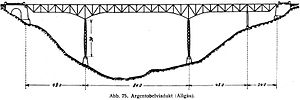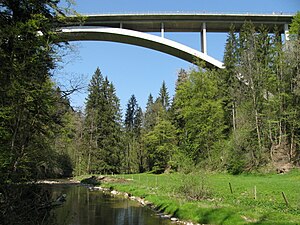Argentobel Bridge
The Argentobel Bridge (also Eistobel Bridge) is a 230 meter long arched bridge made of reinforced concrete on the Bavarian State Road 1318 between the communities of Grünenbach and Maierhöfen in the Lindau district (Lake Constance) . It spans the Obere Argen at a maximum height of 56 meters .
It replaces since 1986, a 1907 built in steel truss executed pendulum pillars Bridge , the Old Argentina Tobel bridge .
Old bridge
| Old Argentobel Bridge | |
|---|---|
| Old Argentobel Bridge (construction scheme) | |
| Convicted | State Road 1318 |
| Subjugated | Upper evil |
| place | Grünenbach , Maierhöfen |
| overall length | 204 m |
| width | 5 m |
| Longest span | 84 m |
| height | 53.6 m |
| Load capacity | 10 t |
| building-costs | 222,000 gold marks (2020: approx. 1,420,000 EUR) |
| start of building | August 1905 |
| completion | February 1907 |
| planner | United Maschinenfabrik Augsburg and Maschinenbauges. Nuremberg AG |
| closure | 1986 |
The first Argentinas Tobel bridge was a steel truss executed pendulum pillars bridge . From 1905 to 1907 it was built by MAN as the longest and highest bridge in Bavaria at the time . The bridge required 340 tons of iron and around 2 million rivets . The central opening of the bridge had a span of 84 meters, the two side openings each had a span of 48 meters. The side fields were installed on fixed scaffolding, the middle field was cantilevered .
The 5.0 meter wide deck was delimited by two railings 1.30 meters high and had two lanes. There were no sidewalks. A man from Maierhöfen-Untersteig was killed in a fall during the construction work.
The new bridge meant an improvement in the connection between Grünenbach and Maierhöfen as well as to Isny in Württemberg . Previously, the road had serpentines from both sides with a gradient of up to 16% down or up into the valley, which made driving with loaded vehicles much more difficult. In winter, Maierhöfen was de facto cut off from its neighboring Bavarian villages and the Allgäu Railway .
At the end of the war in 1945, the bridge was planned to be blown up in order to delay the advance of American troops. The already attached explosive devices (500 kg) were removed by citizens of the neighboring communities and the demolition was prevented. In the following decades the bridge was no longer able to cope with the steadily increasing volume of traffic. Because of the heavy rust formation, its load capacity was reduced from 10 to 3 tons, which meant that bus travelers had to get off and cross the bridge on foot.
In 1980 the bridge was added to the list of monuments as an architectural monument . However, the maintenance costs were too high. After a new bridge was completed in 1985, it was dismantled in 1987.
A model of the old bridge can be seen at the information pavilion of the Eistobel . On the hiking trail down into the valley, the visitor passes a component of the old bridge. An information board explains where exactly on the bridge this part, made of several pieces of iron, was located.
New bridge
Coordinates: 47 ° 38 ′ 30 ″ N , 10 ° 1 ′ 40 ″ E
| New Argentobel Bridge | ||
|---|---|---|
| Argentobel Bridge over the Upper Argen | ||
| Convicted | State Road 1318 | |
| Subjugated | Upper evil | |
| place | Grünenbach , Maierhöfen | |
| construction | Arch bridge | |
| overall length | 230 m | |
| width | 14 m | |
| Longest span | 150 m | |
| height | 56 m | |
| start of building | 1983 | |
| completion | 1986 | |
| planner | BUNG, Heidelberg | |
| location | ||
|
|
||
The new bridge was built from September 1983 to the end of 1985 about 90 meters above the old bridge with construction costs of approx. DM 9 million. The commissioning followed in the summer of 1986. It has two lanes with a total width of 7.5 m as well as sidewalks and cycle paths of 2.0 m width on both sides.
construction
The superstructure is a reinforced concrete slab beam with two webs. The deck is 13.5 m wide between the railings and 24 cm thick in the middle. The bridges have a construction height of 1.5 m. The spans of the 230 m long, 14-span superstructure are 2 × 20.0 m at both ends and 10 × 15 m above the arch. The superstructure is elevated on the arch with monolithically connected pairs of columns. The arch is in the middle of the bridge in the longitudinal direction of the movement rest point. Bearings are available on the abutments and the slope supports.
The reinforced concrete arch in the middle of the bridge has the shape of a parabola and a span of 145 m. On the fighters , the arch clamped there has a construction height of 3.5 m, at the apex it is 2.0 m. The width of the two-cell arch is 8.5 m.
execution
When the Argentobel Bridge was being built, interventions in the landscape and the trees below the arch were not permitted. For the first time in Germany, a simpler and faster method of building arch bridges without free-spanning falsework or guyed cantilever structures was used. In particular, the process dispensed with auxiliary components such as pylons or arc undervoltages. The bridge was built by a consortium using the so-called "arched folding process". The main innovation of the new process: The arch was erected in two halves, standing upright like a bridge pillar with climbing formwork in sections 2.7 to 3.2 m in length. The construction speed was about two sections per week. At first, the arch was temporarily clamped in the fighter foundation. After reaching a height of around 44 m, the restraint was released and temporary steel joint bearings were installed at the foot of the arch halves. After reaching the final height of 81.5 m, this enabled the arch halves to be folded down to close the arch with the help of eight tension bundles anchored back in an anchor block.
Furnishing
Fall protection was installed on the bridge in autumn 2015 as the number of suicide attempts from the bridge had increased. In 2015 alone there were five cases.
literature
- K. Wolf, M. Mühlbauer: New construction of the Argentobel Bridge between Maierhöfen and Grünenbach in the Lindau district In: Tiefbau Berufsgenossenschaft 96 , 1984, pp. 748–755
Web links
Individual evidence
- ↑ a b c d e f Information board in the Eistobel
- ↑ a b c d Bridge over the Argentobel near Grünenbach (Bavaria). In: Zentralblatt der Bauverwaltung , Volume 27, 1907, No. 25 (from March 23, 1907), p. 178. ( digitized version )
- ↑ Road bridge over the Argentobel near Grünenbach in Bavaria. In: Deutsche Bauzeitung , Volume 41, 1907, No. 26 (of March 30, 1907), p. 179. ( Digital ; PDF with 24 MB)
- ↑ a b c K. Wolf, M. Mühlbauer: New construction of the Argentobel bridge between Maierhöfen and Grünenbach in the Lindau district In: Tiefbau Berufsgenossenschaft 96 , 1984, pp. 748–755
- ↑ Riccardo Morandi had used a forerunner of this process at the Ponte Morandi (1953–1955) in Tuscany and developed it further at the subsequent Paul Sauer Bridge in South Africa to become the process that is now mainly used in China (Leonardo Fernández Troyano: Bridge Engineering. A Global Perspective. Colegio de Ingenieros de Caminos, Canales y Puentes, Thomas Telford 2003, ISBN 0-7277-3215-3 , p. 339).
- ↑ Fall protection at the Eistobel bridge in the Lindau district - metal fence to prevent suicides hrsg = allgaeuhit.de. November 19, 2015, accessed August 22, 2016 .
- ↑ Eistobel Bridge is now secured against falling , Lindauer Zeitung, November 21, 2015










